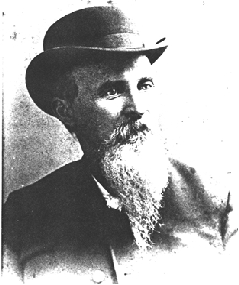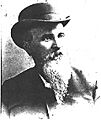Alfred Shea Addis facts for kids
Quick facts for kids
Alfred Shea Addis
|
|
|---|---|
 |
|
| Born | 1832 Philadelphia, Pennsylvania, U.S.
|
| Died | September 10, 1886 (aged 53–54) Chihuahua, Mexico
|
| Cause of death | Gunshot wound |
| Occupation | Photographer |
| Spouse(s) | Sarah Short |
| Children | Yda Hillis Addis, Judge Addis |
Alfred Shea Addis (born 1832 – died September 10, 1886), also known as A.S. Addis, was a photographer who traveled a lot in the American West. He is famous for his pictures of Kansas, Mexico, and the American Southwest.
Contents
Early Life and Photography Beginnings
Alfred Shea Addis was born in Philadelphia, Pennsylvania, in 1832. In 1850, he moved to Lawrence, Kansas. There, he started working for Thomas Short as a photographer's assistant. He learned how to take pictures and soon began getting his own customers.
Addis later married Thomas Short's daughter, Sarah. They had two children: Yda Hillis Addis (born in 1857) and Judge Addis (born in 1862).
Moving to Leavenworth
Life in Lawrence became very unsafe because of conflicts happening before the American Civil War. So, the Addis and Short families moved to Leavenworth, Kansas. They lived close to Fort Leavenworth, which offered them some protection.
In Leavenworth, Alfred Addis opened his own photography business. He offered different types of photos, like "Photographs, Ambrotypes, Melainotypes." He also framed pictures and filled pins and lockets with photos.
At night, Addis managed a place called the Union Theater, which he later bought.
Challenges During the Civil War
As the possibility of the Civil War grew, tensions increased in Leavenworth. In November 1862, Missouri left the Union, and violence broke out. A general named James G. Blunt declared martial law, which meant the military took control.
In August 1863, a group of pro-slavery fighters led by William Quantrill attacked Lawrence. Many pro-Union citizens were killed. Addis held a special show at his Union Theater to raise money for the victims of this attack.
However, in January 1864, people who were against slavery burned down the Union Theater. Because of the ongoing violence and danger, the Addis and Short families decided to leave Kansas. They moved to northern Mexico.
Life in Mexico
The Addises and Shorts first settled in Chihuahua, Mexico. They found other people there who shared their views. Alfred Addis took many photographs of the Mexican landscapes and the local people. He sold his small photo cards, called cartes de visite, to art dealers in New York.
When Addis went exploring to find new places to photograph, he often took his daughter Yda with him. She helped him by translating between English and the local Indian and Spanish languages.
The family later moved further south in Mexico, traveling by mule train to places like Mazatlán and Hermosillo. After the American Civil War ended, Addis and his family sailed on a ship called The Orizaba to California.
Return to the United States
In California, the Addises and Shorts lived in Los Angeles. Yda and her younger brother went to school there. The women in the family took care of the house and rented rooms to others.
Alfred Addis heard about gold and silver being found in New Mexico and Nevada. He left Los Angeles to explore these mining areas. On his journey, he photographed Native American tribes and bought land.
He later moved to Tucson, Arizona, where he was appointed a United States Territorial Marshal. His son, Judge Addis, joined him in Tucson. Sadly, Alfred Addis was later shot and died in Chihuahua, Mexico, on September 10, 1886.
Legacy
Alfred Shea Addis was a very active photographer. His work can be found in many private and public collections today. However, it is not very common to find his original photo cards or prints with his name on them.
Images for kids


